Munich, Germany
The German Octoberfest city

Munich is the capital of Bavaria, and the largest publishing city in Germany. It’s the popular city that hosts the famous annual Oktoberfest celebration. It has lots to offer visitors like wonderful squares, great architecture, lovely castles, and beautiful gardens.

Altes Schloss or Old Palace is an example of a late Renaissance country residence. Today this palace is home to exhibits from the Bavarian National Museum, including an East and West Prussia exhibition, and Gertrud Weinhold’s collection of popular religious art.

St. Peter's Church is a famous landmark in Munich. It sits on a hill towering over the city and offers fantastic views. On clears days from the church you can see all the way to the Alps. A 306 step winding staircase will take you to the top.

The Neue Pinakothek is home to outstanding European art and sculpture from the late 18th century to the beginning of the 20th century. There are displays that focus on German art of the 19th century and many different artworks to admire. One of the highlights is an impressive collection of French Impressionists.
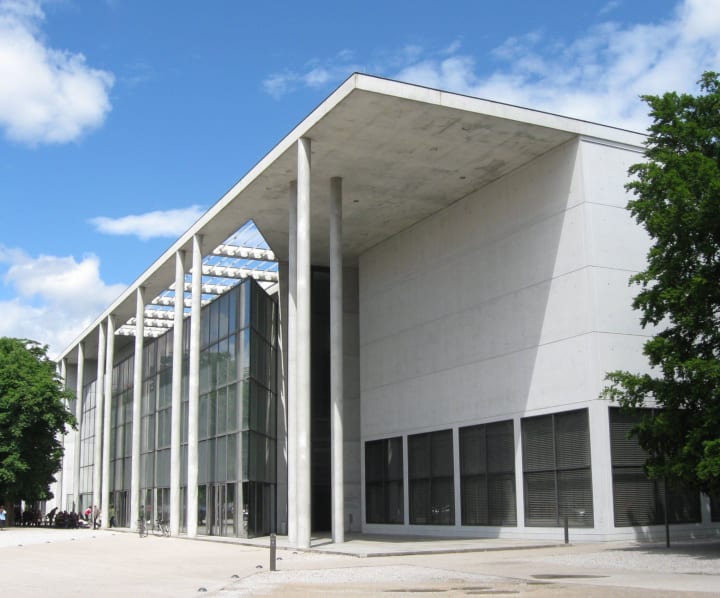
The Pinakothek der Moderne offers fine applied arts of the 20th century to the present. There is also sculpture, photography and video. This is the biggest museum of modern art in Germany.

Schloss Nymphenburg was the Bavarian royal family summer residence with sprawling gardens. The self-guided tour starts in the Gallery of Beauties where you can view 38 portraits of attractive females, chosen by King Ludwig I. Some of the other highlights include the Queen’s bedroom with a sleigh bed upon which Ludwig II was born and the King’s Chamber with impressive ceiling frescoes.

The main building is the Marstallmuseum, which displays royal coaches and riding gear. It includes Ludwig II’s fairytale-like rococo sleigh fitted with oil lamps for the nighttime outings he enjoyed. Upstairs you can see the world’s largest collection of old porcelain that was once made by the famous Nymphenburger Manufaktur, representing the entire product palette from the founding of the company in 1747 until 1930.

Residents and visitors alike love the sprawling park behind Schloss Nymphenburg. It is a great place for walking, jogging and just relaxing. The park has been laid out in English style with a large lake, a cascade, and a canal. The canal is popular for feeding swans and ice skating in the winter when it freezes over.

At the Kugelweither Pond there are water lilies, croaking frogs and solitude.

One of the most popular things in the park is the Amalienburg, an elaborate hunting lodge dripping with crystal and gilt decoration.
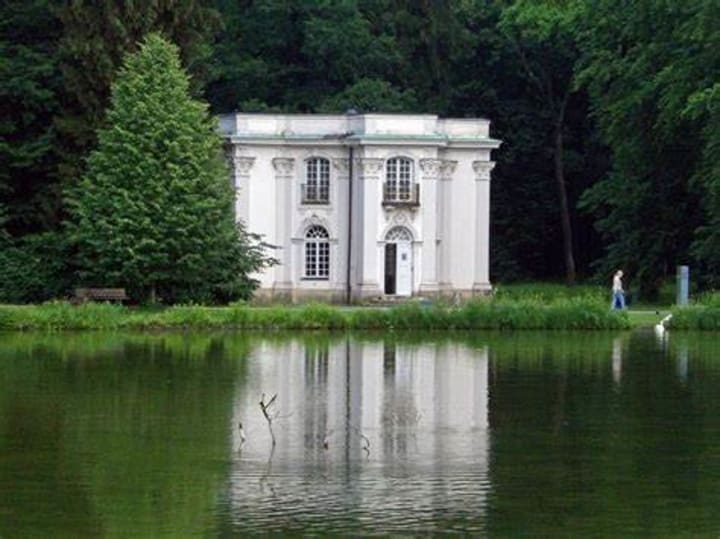
Don’t miss the amazing two-story Pagodenburg, a Chinese teahouse built in the early 18th century. It is decorated with ceramic tiles that depict landscapes, figures and floral ornamentation. There is also the Badenburg a sauna and bathing house with its original heating system and the Magdalenenklause built as a mock hermitage.

Located in Marienplatz in Munich’s Old Town is the Cathedral Church of Our Lady. Construction was started in 1468. It was damaged during WW II and rebuilt. Visitors can climb the south tower of the cathedral to get fantastic views over the city and toward the Alps. At the entrance of the late-Gothic interior you’ll find the devil’s footprint in the floor of the church. There is the impressive tomb of the princes under the chancel. The oldest resting place in Munich for the Wittelsbachs is also the tomb of the Holy Roman Emperor Ludwig the Bavarian.

Back in 1789 Elector Carl Theodor, ordered to have a public park established by the Isar River. It became the project of Briton Benjamin Thompson, who was working for the Bavarian Army at the time. The park was named Englische Garten, and was laid out in the style of an English country park.

Today it offers residents and visitors many different leisure time activities such as cycling and jogging. There are lovely paths for strolling and fields for soccer players. Visit the Japanese teahouse the Monopteros that offers a lovely view of the city. It was first opened in 1972 on an artificial island in the Schwabinger Bach stream. Japanese tea ceremonies are performed here regularly.

There is a beer garden near the Chinese Tower is Munich’s second largest. The pagoda stands 25 meters high and is based on a design dating from 1789.

Another beer garden can be found on Kleinhesseloher Lake. The Restaurant Seehaus here is open all year round. Behind the restaurant starts the northern part of the park where you can find the Restaurant Aumeister with another beer garden.

Eisbacwelle is the place to do the unusual in Munich – surfing. From beneath a small bridge water comes thundering out. Surfers line both sides of the bank, jump off the bank, and onto their surfboards. They tackle the waves year round.

The Botanical Garden is open all year round. There are greenhouses with a tropical climate. In the spring and summer about 14,000 different kinds of plants grow. Inside and outside are cacti of all shapes and sizes. There are carnivorous jungle plants and domestic walnut trees. Visitors can also see many different species of birds and insects. Threatened wild bees are protected here and important for the plants. In the ponds you can see frogs and turtles.

The heart and soul of the Altstadt, Marienplatz, is a popular gathering spot and packs a lot of personality into a compact frame. It's anchored by the Mariensäule (Mary's Column), built in 1638 to celebrate the victory over Swedish forces during the Thirty Years' War. At 11am and noon (also 5pm March to October), the square jams up with tourists craning their necks to take in the cute carillon in the Neues Rathaus (New Town Hall)

The facade of this neo-Gothic fantasy is festooned with gargoyles, statues and a dragon scaling the turrets; the tourist office is on the ground floor. For pinpointing Munich's landmarks without losing your breath, catch the lift up the 85 m-tall tower.

The carillon has 43 bells and 32 figures that perform two actual historic events. The top half tells the story of a knight's tournament held in 1568 to celebrate the marriage of Duke Wilhelm V to Renata of Lothringen, while the bottom half portrays the Schäfflertanz. If you want to see the show at eye level, head to the top floor of the Hugendubel bookstore or enjoy the Café Glockenspiel.
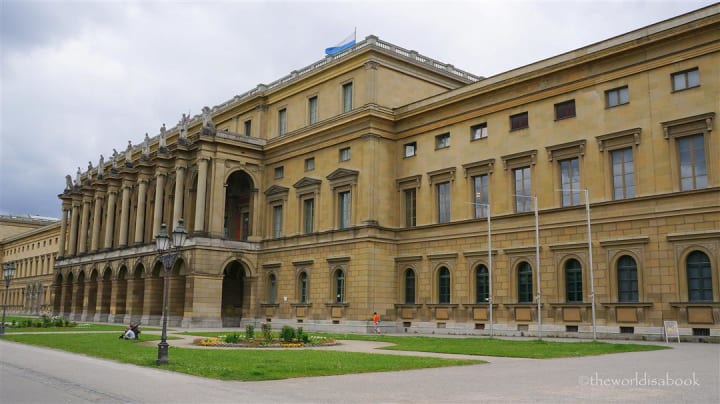
The Residenz is a suitably grand palace that reflects the splendor and power of the Wittelsbach clan, the Bavarian rulers who lived here from 1385 to 1918. The edifice dwarfs Max-Joseph-Platz along with the grandiose National Theater, home to the Bavarian State Opera. Its museums are among the jewels in Munich's cultural crown and an unmissable part of the Bavarian experience.

Four giant bronze lion statues guard the entrance to the palace on Residenzstrasse, supported by pedestals festooned with a half-human, half-animal face. Note the creatures' remarkably shiny noses. If you wait a moment, you'll see the reason for the sheen: scores of people walk by and casually rub one or all four noses. It's supposed to bring wealth and good luck.

If you can imagine it the Statue of Liberty Munich-style stands guard over the Oktoberfest grounds every years. The statue was erected by King Ludwig I in 1850. Inside the statue is a spiral staircase leading to an observation deck from which you can see the Oktoberfest area and downtown Munich.
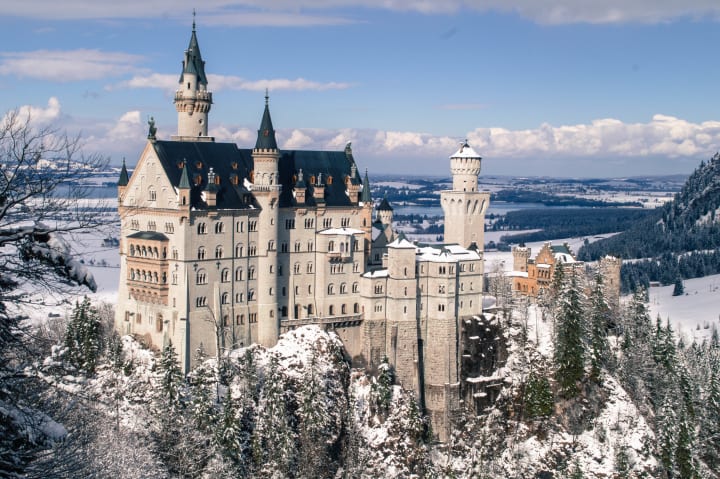
Neuschwanstein Castle located in southern Bavaria is one of the most photographed sights in Germany. It is the creation of King Ludwig II. Among the highlights here are the Singer's Hall and the Hall of the Holy Grail.

The Angel of Peace monument is a 25 meter tall Corinthian column topped by a gilded bronze statue of the angel. It was modeled after the statue of Nike – Goddess of Victory. The column is set on top of a plinth. Gilded mosaics beneath the platform for figures that represent War, Peace, Victory, and Culture. A double staircase leads to a fountain at the foot of the monument, The fountain is decorated with statues of putti, sitting on water spouting sea creatures.
About the Creator
Rasma Raisters
My passions are writing and creating poetry. I write for several sites online and have four themed blogs on Wordpress. Please follow me on Twitter.





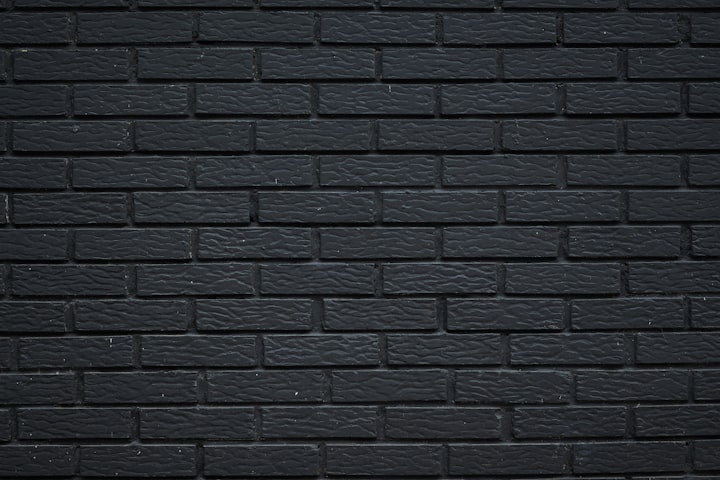
Comments
There are no comments for this story
Be the first to respond and start the conversation.